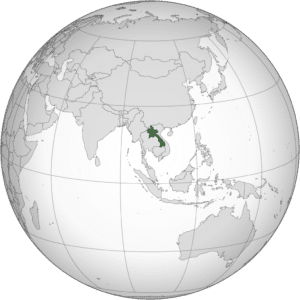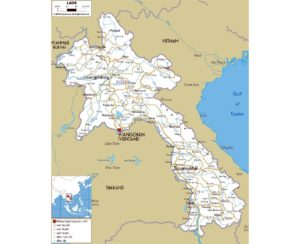Introduction:
Laos, officially the Lao People’s Democratic Republic, is a socialist state and the only landlocked country in Southeast Asia. At the heart of the Indochinese Peninsula, Laos is bordered by Myanmar and China to the northwest, Vietnam to the east, Cambodia to the southeast and Thailand to the west and southwest.

Present Laos traces its historic and cultural identity to Lan Xang, which existed from the 14th century to the 18th century as one of the largest kingdoms in Southeast Asia. Due to its central geographical location in Southeast Asia, the kingdom became a hub for overland trade, and became wealthy economically and culturally. After a period of internal conflict, Lan Xang broke into three separate kingdoms—Luang Phrabang, Vientiane, and Champasak. In 1893, the three territories came under a French protectorate and were united to form what is now known as Laos. It briefly gained independence in 1945 after Japanese occupation, but was recolonized by France until it won autonomy in 1949. Laos became independent in 1953, with a constitutional monarchy under Sisavang Vong. A post-independence civil war began, which saw the communist resistance, supported by the Soviet Union, fight against the monarchy that later came under influence of military regimes supported by the United States. After the Vietnam War ended in 1975, the communist Pathet Lao came to power, ending the civil war. Laos was then dependent on military and economic aid from the Soviet Union until its dissolution in 1991.
In 2018, the country had the eighth highest GDP (PPP) per capita in Southeast Asia. Laos is a member of the Asia-Pacific Trade Agreement, the ASEAN, East Asia Summit, and La Francophonie. Laos applied for membership of the World Trade Organization in 1997; on 2 February 2013, it was granted full membership. It is a one-party socialist republic, espousing Marxism–Leninism governed by the Lao People’s Revolutionary Party, under which non-governmental organizations have routinely characterized the country’s human rights record as poor, citing repeated abuses such as torture, restrictions on civil liberties, and persecution of minorities.

Laos opened in 1986 to the “new economic mechanisms”. The Investment Code was promulgated in 1988. It opens the economy to foreign participation and promotes the notions of profit, profitability and productivity. Since then, private enterprise has been considered as the center of the “new economic management system”. A first Structural Adjustment Program was adopted in 1989 with the support of the IMF and the World Bank. Since 2009, the United States has recognized Laos as a country respectful of the market economy. Thanks to this recognition, American companies investing in the country can receive public aid.
In Laos, the politically and culturally dominant Lao people make up 53.2% of the population, mostly in the lowlands. Mon-Khmer groups, the Hmong, and other indigenous hill tribes live in the foothills and mountains. Laos’s strategies for development are based on generating electricity from rivers and selling the power to its neighbours, namely Thailand, China, and Vietnam, as well as its initiative to become a “land-linked” nation, as evidenced by the construction of four new railways connecting Laos and neighbours. Laos has been referred to as one of Southeast Asia and Pacific’s Fastest Growing Economies by the World Bank with annual GDP growth averaging 7.7% since 2009.
History:
Early History:
An ancient human skull was recovered in 2009 from the Tam Pa Ling Cave in the Annamite Mountains in northern Laos; the skull is at least 46,000 years old, making it the oldest modern human fossil found to date in Southeast Asia.
